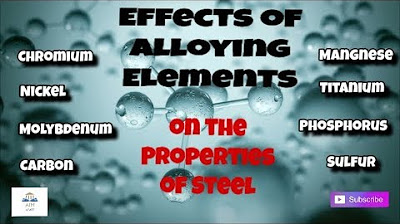Failure Statistics & Maintenance Methods - Aircraft Structures - Airframes & Aircraft Systems #3
Summary
TLDRThis lesson delves into the materials used in aircraft construction, focusing on aluminum alloys, steel, titanium, and composites, each chosen for specific properties like strength and corrosion resistance. It addresses corrosion's impact on aircraft, detailing different types and their detection. The effects of hard landings on structures are examined, along with fail-safe design principles to ensure flight safety. The lesson concludes with an overview of maintenance methods, emphasizing the importance of regular inspections and repairs to maintain aircraft integrity.
Takeaways
- 🛩️ Modern aircraft primarily use aluminum alloys, with smaller amounts of steel and titanium, for structural components, and composite materials for lighter structures.
- 🌟 Aluminum alloys are favored for their excellent strength-to-weight ratio, with duralumin being a popular choice for airliner skins despite its poor corrosion resistance.
- ⚙️ Steel alloys are used where strength is crucial and weight is less of a concern, such as in undercarriage units, while titanium is chosen for its strength and fire resistance, especially in engine firewalls.
- 🔬 Magnesium alloys offer a superior strength-to-weight ratio but are limited in primary structures due to poor elastic properties; they are often used in gearboxes.
- 📈 Composite materials are increasingly used in aircraft construction for their high specific strength, stiffness, and resistance to corrosion, with the Airbus A380 notably utilizing a significant amount in its construction.
- 🔩 Corrosion is a significant issue in aircraft, with surface corrosion being the least damaging and intergranular corrosion being particularly dangerous due to its隐蔽 nature and potential for sudden failure.
- 🛑 Hard landings can cause damage to the landing gear, wings, and fuselage, emphasizing the importance of inspection and maintenance to ensure flight safety.
- ⚠️ The fail-safe design concept in aircraft includes redundancy, isolation of systems, and proven reliability to prevent catastrophic failures even in the event of component malfunctions.
- 🔧 Maintenance methods for aircraft include hard time maintenance, which is scheduled based on time or cycles, and on-condition maintenance, which is based on the physical condition of the components.
- 📊 The probability and severity of failures are closely managed, with catastrophic failures being extremely improbable and minor failures being more likely but with less severe consequences.
Q & A
What are the primary materials used in the construction of modern aircraft?
-Modern aircraft are primarily constructed of aluminum and its alloys, with smaller amounts of steel and titanium used for major structural components. Composite materials are also extensively used for more lightly loaded structures.
Why is aluminum alloy the most widely used metal for structural use in aircraft?
-Aluminum alloys are the most widely used metals for structural use due to their good strength-to-weight ratio, which is crucial for flight efficiency.
What is duralumin and why is it used in aircraft construction?
-Duralumin is an aluminum-copper based alloy known for its good thermal and electrical conductivity and fatigue resistance. It is used for airliner skins, especially when clad with pure aluminum to improve corrosion resistance.
How is titanium utilized in aircraft, and what are its advantages?
-Titanium is used in aircraft where fire protection is required, such as in engine firewalls, due to its strength, light weight, and corrosion resistance at high temperatures. The SR-71 Blackbird was an early adopter, and its use has since spread to modern fighter and commercial aircraft.
What is the significance of composite materials in aircraft construction?
-Composite materials are significant in aircraft construction because they offer high specific strength and stiffness, along with the ability to retain these properties at high temperatures. They are used in both structural and non-structural components for weight savings and resistance to corrosion.
How does corrosion affect aircraft materials, and what are the common types of corrosion?
-Corrosion affects aircraft materials through electrochemical reactions, leading to their slow destruction. Common types of corrosion include surface corrosion, intergranular corrosion, and stress corrosion, each with varying levels of detectability and damage.
What is the impact of a hard landing on an aircraft's structure?
-A hard landing can cause damage to the aircraft's landing gear, supporting structure, wings, and fuselage, as well as secondary damage depending on the aircraft's configuration and loading. Hard landing indicators may provide a visual indication when specific g-forces are exceeded.
What is the fail-safe concept in aircraft design, and how does it relate to failure classifications?
-The fail-safe concept in aircraft design ensures that a single failure of any system or component does not lead to a catastrophic outcome. Failures are classified into five groups based on severity, and the likelihood of a failure occurring is inversely related to its severity.
How do redundancy and backup systems contribute to the fail-safe design of aircraft?
-Redundancy and backup systems in aircraft design allow for continued function after the failure of one or more systems, ensuring that the aircraft can maintain safe operation even in the event of component failures.
What are the two common maintenance methods for aircraft structures and components?
-The two common maintenance methods are hard time maintenance, which involves periodic overhauls based on flight hours or time, and on-condition maintenance, which requires periodic inspections to determine if a part can continue in service.
Outlines

هذا القسم متوفر فقط للمشتركين. يرجى الترقية للوصول إلى هذه الميزة.
قم بالترقية الآنMindmap

هذا القسم متوفر فقط للمشتركين. يرجى الترقية للوصول إلى هذه الميزة.
قم بالترقية الآنKeywords

هذا القسم متوفر فقط للمشتركين. يرجى الترقية للوصول إلى هذه الميزة.
قم بالترقية الآنHighlights

هذا القسم متوفر فقط للمشتركين. يرجى الترقية للوصول إلى هذه الميزة.
قم بالترقية الآنTranscripts

هذا القسم متوفر فقط للمشتركين. يرجى الترقية للوصول إلى هذه الميزة.
قم بالترقية الآنتصفح المزيد من مقاطع الفيديو ذات الصلة

Understanding Piping Materials:A53 vs A106, SS304 vs SS316|| difference between piping materials

Materials Selection

Introduction to engineering materials

Steel Types - Stainless Steel Vs Carbon Steel Explained.

Effects of alloying Elements on the Properties of steel. ||Engineer's Academy||

Understanding Metals
5.0 / 5 (0 votes)
